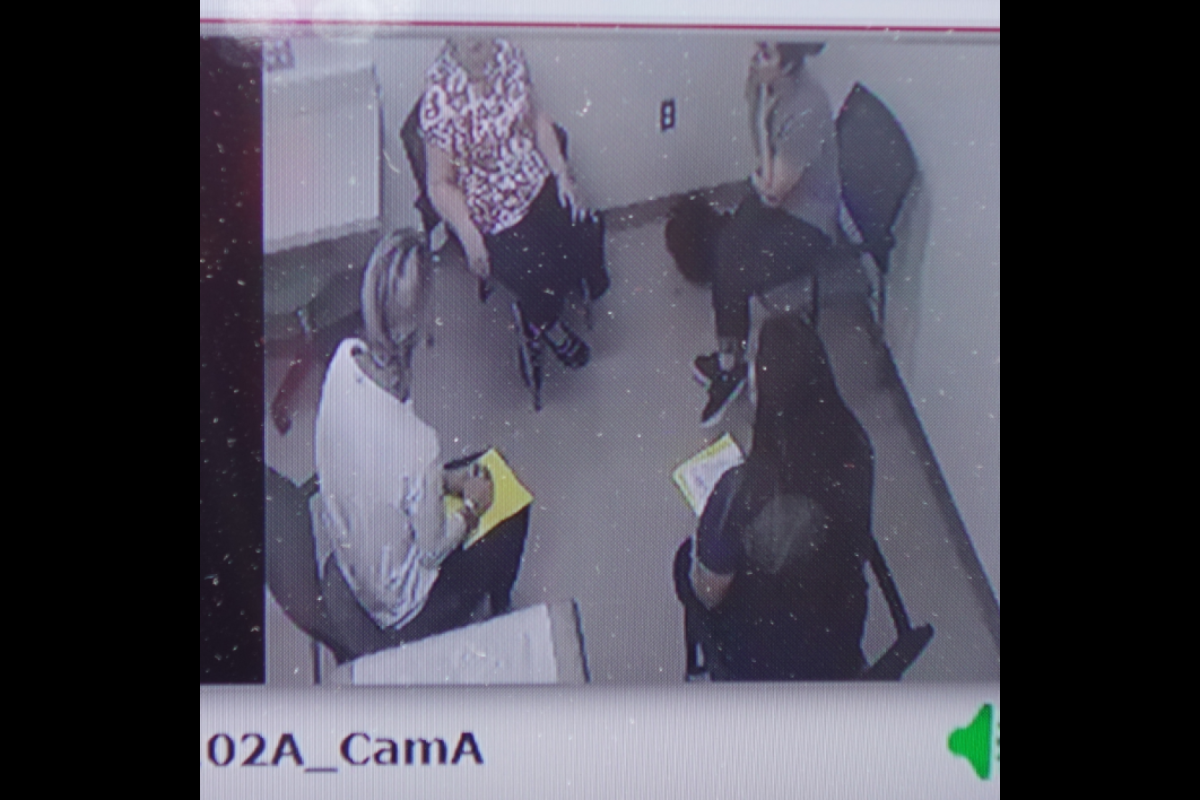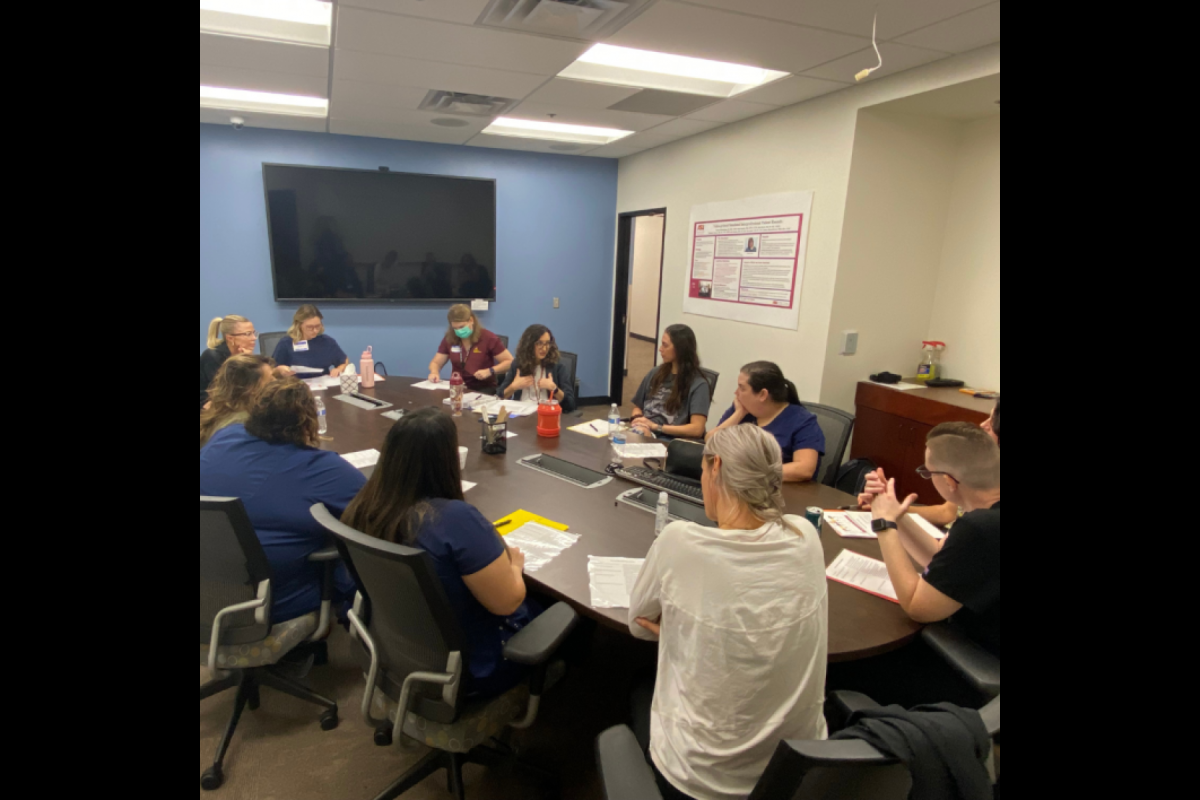Through tears, a patient in her 60s asks what she could have done differently after nurses Alina and Viva break the news that she has breast cancer.
Empathetically, the pair explain that it’s not the woman’s fault, that these things happen and, because she has had regular mammograms, it appears they likely caught it early, offering reassurance that she has done everything right.
After answering all of her questions and providing resources and contact information, they stepped out of the room to debrief.
That tough conversation was part of a simulated scenario for doctor of nursing practice students in ASU’s Edson College of Nursing and Health Innovation taking part in the “Breaking Bad News” workshop this month.
“When I heard about the workshop, I felt it was something I needed to know. Being a nurse and now becoming a nurse practitioner, I feel like I need to be more aware of how I present things to the patient. This workshop is helping me learn those skills,” Nneka Onyia said.
Onyia is one of 28 students who participated in the half-day workshop. The students started off learning about therapeutic communication techniques and a validated, evidence-based communication tool known as the SPIKES protocol to “break” bad news, as well as how to navigate family and patient responses and emotions to the news.
“Especially in our new roles as nurse practitioners, we’ll be the ones who will be giving this information,” said DNP student Kristine Murdock. “It could be a cancer diagnosis or news of an STD or the loss of pregnancy; those are just some of the situations we might encounter.”
After learning about the evidence-based methodology for delivering tough news, the students moved into the hands-on portion of the day. During this part of the workshop, they rotated between stations practicing their new skills on simulated patients, similar to the breast cancer diagnosis scenario described above. They also worked on delivering different types of bad news to each other.
“There are a lot of times you don’t know how your patients are going to react, and sometimes it can trip you up, and you want to make sure you’re saying the right things. Having this exercise and education to help reinforce that and to provide confidence in knowing that I’m doing the right thing for the patient is great,” Murdock said.
That’s precisely what workshop creators and Edson College faculty members Erin Tharalson and Janet O’Brien were aiming for.
“Our goal is that this will build student nurse practitioners’ confidence in having these tough conversations in their future practice,” Clinical Assistant Professor Tharalson said.
Clinical Professor O’Brien shared that the idea for this workshop started percolating about four years ago when Hospice of the Valley reached out with an interest in collaborating and using simulation to help train their staff.
Eventually, a simulation case was developed, and O’Brien, Tharalson and a gerontology nurse practitioner from Hospice of the Valley conducted a small pilot with four student volunteers in 2019 to test it out.
“Outcomes of the pilot were highly successful,” O’Brien said. She said they later presented their findings at the National League of Nursing Education Summit in 2021. That led to them applying for and getting a $2,000 grant from the Association of SP Educators (ASPE) in 2022.
So it was only fitting that Hospice of the Valley volunteered to participate in the workshop as well. Guest lecturers were able to offer students their expert insights and feedback during the debriefing sessions.
O’Brien said those sessions, where students received constructive feedback on their behaviors from the simulated patients as well as the faculty volunteers and other health care professionals, were key.
“It’s an invaluable experience that will help them improve their skills and become more effective in patient care,” O’Brien said
In the past, the topic of breaking bad news has not been traditionally covered in nurse practitioner education. Due to the pandemic and an increased focus on simulation-based learning, it's now taking a front seat.
“In our program, students are educated in therapeutic communication and motivational interviewing, so this particular area is our next area of focus to bring in and round out that education,” said Tharalson.
For this particular workshop, students volunteered to attend and received indirect patient care hours for participating, as the workshop addressed several program essentials.
All of the students who took part in the workshop showed enthusiasm and support for the potential to one day incorporate this topic more fully into the DNP curriculum.
“As providers, regardless of specialty, you will encounter situations where you’ll be telling patients something they don’t want to hear. Being able to know how to navigate through that is a good skill to have,” Onyia said.
Top image: During the workshop, students practiced delivering different types of bad news to each other.
More Health and medicine

ASU's Roybal Center aims to give older adults experiencing cognitive decline more independence
For older people living alone and suffering from cognitive decline, life can be an unsettling and sometimes scary experience.Arizona State University is out to improve that experience.Two projects…

Dynamic data duo advances health research
The latest health research promises futuristic treatments, from cancer vaccines to bioengineered organs for transplants to medical nanobots. While these technologies may one day be…

New study reveals high levels of toxins in seized cannabis from Arizona and California
A recent study conducted by researchers from Arizona State University has uncovered alarming levels of Fusarium mycotoxins in illicit cannabis samples seized in Arizona and California.The study found…






